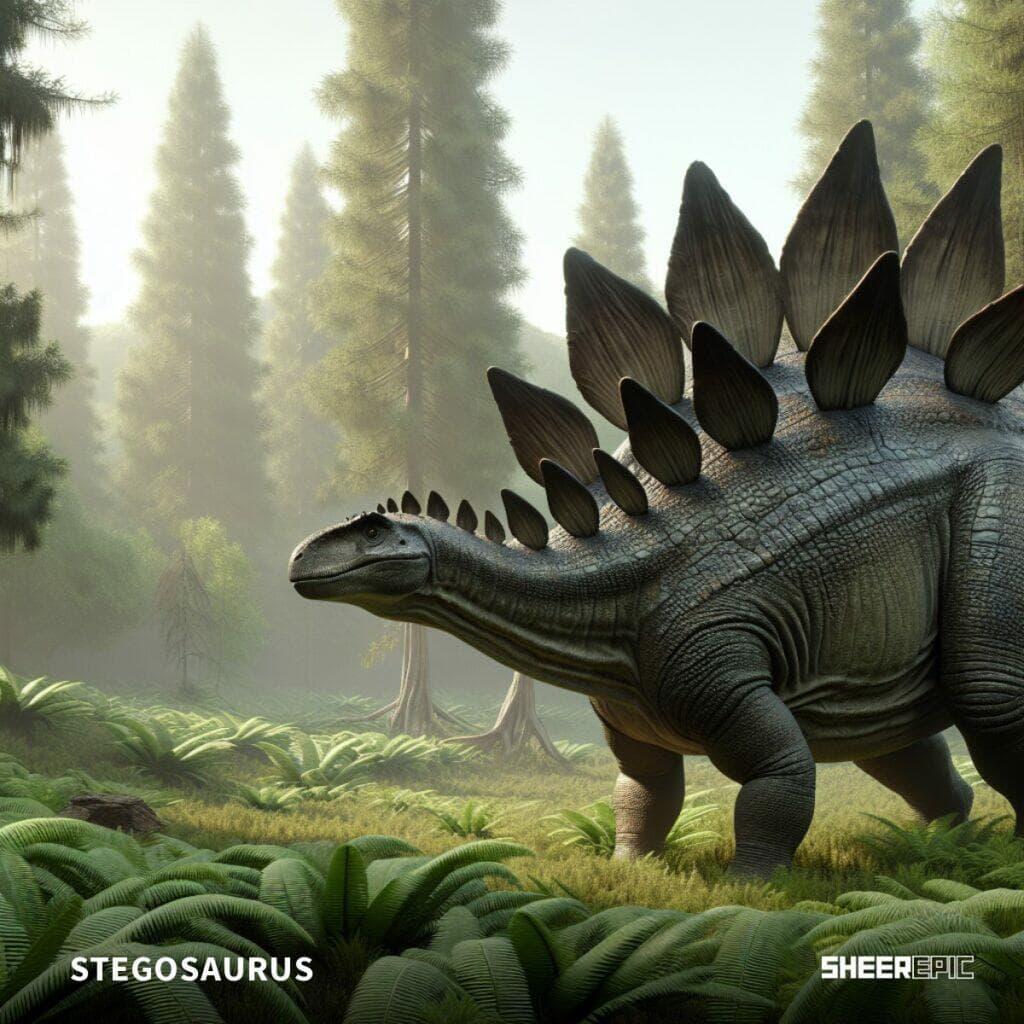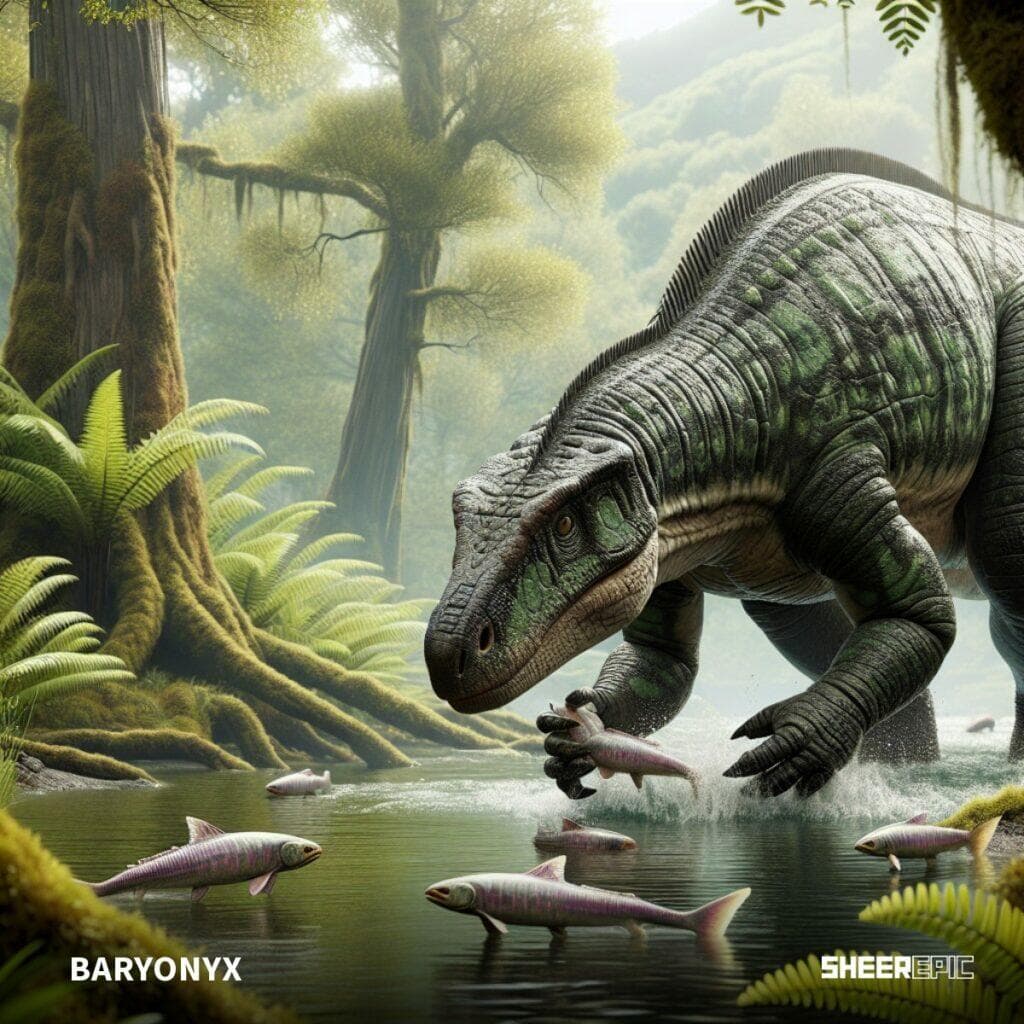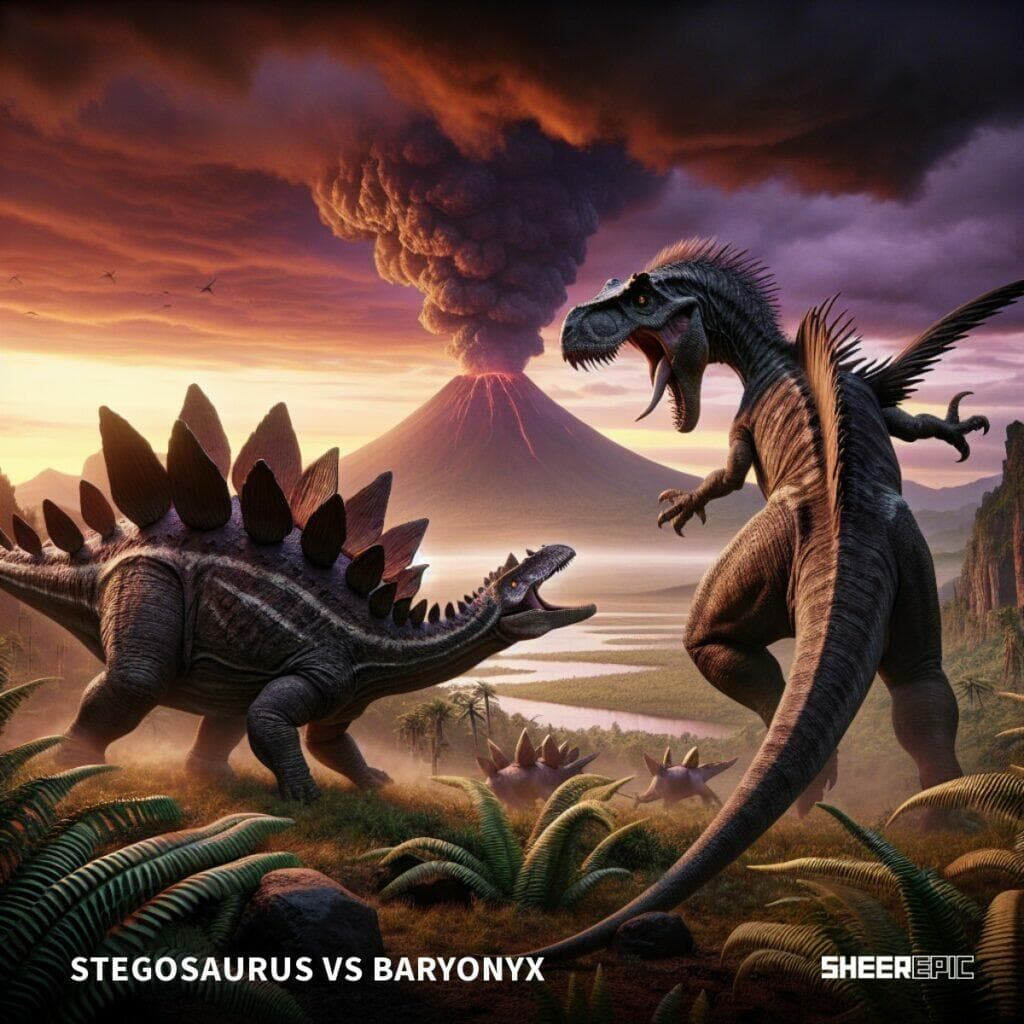The Stegosaurus and Baryonyx were two very different dinosaurs that lived during distinct time periods. The Stegosaurus inhabited the Earth during the Late Jurassic period and was known for its distinctive kite-shaped plates along its back and spikes on its tail.
On the other hand, the Baryonyx was a theropod dinosaur that roamed during the Early Cretaceous period, featuring a unique set of elongated crocodile-like jaws and large claws. Despite their striking differences, many people wonder who would win in a hypothetical encounter between these two prehistoric creatures.
To determine the victor in this imagined battle, one must consider several factors such as their physical characteristics, diet, hunting strategies, defense mechanisms, and social behavior. It is essential to analyze these aspects in the context of their respective environments, and how they might have influenced the outcome of a potential clash between the two species.
Key Takeaways
- Stegosaurus and Baryonyx were distinct dinosaurs with unique physical characteristics and lived during different time periods.
- Examining factors such as diet, hunting strategies, and defense mechanisms can help determine a hypothetical winner.
- Comparing these prehistoric creatures can provide insight and stimulate engaging discussions about their lives and behaviors.
Table of Contents
Comparison
The Stegosaurus and Baryonyx were two very different types of dinosaurs that lived in different periods. The Stegosaurus lived in the Late Jurassic period, around 155-150 million years ago, and was predominantly found in North America and Europe, whereas the Baryonyx lived in the Early Cretaceous period, around 130-125 million years ago, and was discovered in England.

In terms of size, the Stegosaurus was considerably larger compared to the Baryonyx. The Stegosaurus could reach a length of about 9 meters and weighed around 5 tons, while the Baryonyx had a length of about 7.5 meters and weighed around 1.7 tons. The distinctive feature of the Stegosaurus was its kite-shaped upright plates along its back, while the Baryonyx had a long, narrow snout and large curved claw on its first finger.
Regarding speed, the Stegosaurus was not known for being fast. Its estimated maximum speed likely ranged from 5-7 km/h due to its massive size and short legs. The Baryonyx, on the other hand, was more agile and could potentially be faster than the Stegosaurus, but its exact speed remains unknown.

In a hypothetical battle, the Baryonyx’s agility and long snout, which may have served as a weapon for catching fish, would not likely result in a significant advantage against the massive Stegosaurus. Moreover, the Stegosaurus had tail spikes, known as thagomizers, which were likely used for self-defense and could inflict significant damage.
Comparison Table
| Comparison | Stegosaurus | Baryonyx |
|---|---|---|
| Period | Late Jurassic (155-150 million years ago) | Early Cretaceous (130-125 million years ago) |
| Location | North America, Europe | England |
| Size | Length: Approximately 9 meters | Length: Approximately 7.5 meters |
| Weight: Around 5 tons | Weight: Around 1.7 tons | |
| Distinctive Features | Kite-shaped upright plates along its back | Long, narrow snout and large curved claw on its first finger |
| Tail Spikes | Stegosaurus had a series of sharp, pointed tail spikes known as “thagomizers” that were likely used for self-defense against predators. These spikes could inflict significant damage. | No known tail spikes or similar defensive structures. |
| Speed | Estimated maximum speed: 5-7 km/h | Unknown, potentially faster than Stegosaurus |
| Other Abilities | Stegosaurus had a small brain relative to its body size, but it possessed a complex system of plates and spikes that may have played a role in thermoregulation, display, or defense. | Baryonyx had a long, narrow snout that may have been adapted for catching fish. It also had a large curved claw on its first finger, possibly used for hunting or defense. |
Stegosaurus:
- Herbivorous dinosaur
- Quadrupedal with a small head and leaf-shaped teeth
- Known for its back plates and tail spikes for defense
- Lived during the Jurassic period, alongside other dinosaurs such as Allosaurus and Ceratosaurus
Baryonyx:
- Carnivorous dinosaur
- Bipedal with strong arms and large, crocodile-like teeth
- Part of the Spinosaurid family, which also includes Spinosaurus and Suchomimus
- Lived during the Early Cretaceous period, alongside dinosaurs such as Iguanodon and Carnotaurus
Physical Characteristics
The Stegosaurus was a herbivorous dinosaur that lived during the Late Jurassic period. Its most distinctive features were the kite-shaped upright plates along its back and the spikes at the end of its tail. The length of a fully grown Stegosaurus could reach up to 9 meters (30 feet), standing at a height of about 2.75 meters (9 feet) at the hips Stegosaurus. This massive creature could weigh between 4.4 to 5.5 tons. Its body was supported by four sturdy legs, with the front legs being shorter than the rear ones.
The Baryonyx was a theropod dinosaur that lived during the Early Cretaceous period. It was a carnivorous dinosaur and its features included a long, narrow snout filled with sharp teeth and a large, curved claw on its first finger Baryonyx. This dinosaur had a more streamlined body, reaching lengths of up to 7.5 meters (25 feet) and heights of up to 2 meters (6.5 feet) at the hips. Although it was smaller than the Stegosaurus, the Baryonyx was still a formidable predator, with an estimated weight of 1.2 to 1.7 tons.
In terms of size, the Stegosaurus was both larger and heavier than the Baryonyx. The additional weight and height of the Stegosaurus might have given it a better chance of fending off attacks from predators like the Baryonyx. The plates on the back of the Stegosaurus not only gave it an imposing appearance but could have also served as a deterrent to those considering engaging it in combat.
However, the Baryonyx’s carnivorous nature and the presence of sharp teeth and claws could give it the edge when it comes to pure fighting ability. Its long snout, filled with sharp teeth perfect for catching fish, might have been equally effective at delivering powerful bites to opponents. Additionally, the large, curved claws on the Baryonyx’s hands would likely be effective in close-quarters combat.
While the Stegosaurus had a size advantage, the Baryonyx boasted a set of powerful weapons specifically adapted for hunting and fighting. Both dinosaurs had unique physical characteristics that would play a significant role if they were to engage in a battle.
Diet and Hunting
The Stegosaurus and Baryonyx were two very different dinosaurs in terms of their diet and hunting habits. The Stegosaurus was a herbivore, while the Baryonyx was a carnivore, with specialized features helping them to consume their respective food sources.
The Stegosaurus primarily fed on plants, relying on its small, peg-like teeth to break down plant material. Its beak-like mouth allowed it to strip leaves from branches, and its low, wide body enabled it to graze close to the ground. Being a herbivore, Stegosaurus did not require strong jaws or sharp teeth to hunt and consume prey like carnivorous dinosaurs did.
In contrast, Baryonyx was a carnivorous theropod, preying on fish and other smaller animals. Its teeth and jaws were suited for this purpose, with its long, crocodile-like snout containing numerous, conical teeth. These teeth were perfect for gripping and holding onto slippery fish, while its strong jaw muscles allowed it to crush bones. Baryonyx’s large thumb claws were also used for catching fish and tearing into the flesh of its prey.
As a carnivorous dinosaur, Baryonyx would have been an active hunter. It likely had a great sense of smell, helping it to detect its prey from a distance. Its elongated body and strong legs allowed for quick movement, making it an efficient predator. Meanwhile, Stegosaurus did not face the same challenges in searching for food, enabling it to lead a relatively more sedentary lifestyle.
Defense Mechanisms
The Stegosaurus and Baryonyx were two very different dinosaurs with unique defense mechanisms. The primary defensive features of a Stegosaurus include its bony plates and thagomizer, while a Baryonyx relies on its claws and powerful limbs.
Stegosaurus, a herbivorous dinosaur, was known for the distinctive kite-shaped upright plates along its back. These plates served multiple purposes, including protection from predators. They made the dinosaur appear larger and more intimidating when confronted by a potential attacker. Additionally, the plates could have provided some level of physical protection by deflecting or absorbing incoming blows.
Another significant defense mechanism of the Stegosaurus is its spiked tail, also known as the thagomizer. This feature consisted of sharp, sturdy spikes extending from the tail, which the dinosaur could swing in a wide arc. The thagomizer acted as a potent weapon, delivering powerful blows that could cause significant harm to a predator attempting to approach the Stegosaurus from behind.
On the other hand, the Baryonyx, a carnivorous dinosaur, had a different set of defense mechanisms. Rather than possessing armor-like plates, its primary weapons were its large, curved claws, which it could use to slash and tear at its opponents. The strong limbs of the Baryonyx gave it an advantage in close encounters, allowing it to hold its ground and potentially overpower smaller foes.
Although the Baryonyx had no distinctive bony plates or horn-like structures, its physical attributes still played a role in its defense. Its powerful build, combined with its sharp claws, would have made it a formidable opponent for any would-be predator.
Intelligence and Social Behavior
The Stegosaurus and Baryonyx, members of the Stegosauridae and Baryonychinae families respectively, exhibit differences in intelligence and social behavior.
Stegosaurus, a herbivorous dinosaur, is known for its distinctive plates and spikes on its back and tail. The small brain of the Stegosaurus, relative to its body size, suggests a limited capacity for complex thinking. However, these dinosaurs may have relied on instinct and simple communication methods to interact with others in their group. It is believed that they lived in herds, providing them with protection from predators and aiding them in foraging for food.
On the other hand, Baryonyx, a carnivorous dinosaur, possessed a larger brain proportionately, which may have contributed to increased problem-solving abilities and adaptability. Baryonyx had a distinctive elongated snout with sharp teeth, enabling it to efficiently catch and eat fish. Currently, there is limited evidence regarding Baryonyx’s social behavior, but its potential intelligence could imply at least some social interaction within their species, possibly for hunting or raising offspring.
In terms of comparing the intelligence of the Stegosaurus and Baryonyx, it is likely that the Baryonyx had a higher cognitive capacity due to its larger brain relative to body size. As for social behavior, both species may have engaged in different forms of interaction within their respective groups.
Key Factors
When assessing the potential winner in a match-up between a Stegosaurus and a Baryonyx, we must consider several key factors.
Firstly, the physical attributes of both dinosaurs play an essential role in determining the outcome. The Stegosaurus was a herbivorous dinosaur with a row of large, plate-like structures along its back and a spiked tail. They could grow up to 9 meters long and weigh up to 5,000 kilograms. In contrast, the Baryonyx was a carnivorous theropod that lived during a different geological era. It had a long, crocodile-like snout filled with sharp teeth and powerful forelimbs equipped with large, hook-like claws. This dinosaur could be over 9 meters long, and it is estimated to have weighed around 1,700 to 2,000 kilograms.
Another essential factor to consider is the weakness of each species. The Stegosaurus, with its relatively small brain and slow speed, may not have been agile or quick-thinking when faced with a predator. However, its plated armor and heavy spiked tail were effective self-defense mechanisms. In the case of the Baryonyx, it was likely not as heavily built or powerful as some of the larger theropods, such as the T-Rex or Spinosaurus, which might put it at a disadvantage against well-armed opponents.
Thermoregulation in dinosaurs is still a topic of debate among paleontologists. Some evidence, such as the large surface area of Stegosaurus’ plates, suggests that this dinosaur may have used its plates for regulating body temperature. However, if the Baryonyx, like other theropods, had feathers, it might have used them to help maintain a stable body temperature, giving it an advantage in different environmental conditions.
Taking all these factors into account, we can attempt to ascertain which dinosaur would have the upper hand in this hypothetical battle. The Baryonyx’s carnivorous nature and large claws might give it an offensive advantage, while the Stegosaurus’ defensive capabilities would make it a challenging foe to defeat.
Who Would Win?
In a hypothetical encounter between Stegosaurus and Baryonyx, both dinosaurs would likely have unique advantages and disadvantages in a battle.
Stegosaurus, an herbivorous dinosaur from the Jurassic period, was equipped with large bony plates on its back and a spiked tail for defense against predators like Allosaurus. Meanwhile, Baryonyx was a theropod dinosaur from the Early Cretaceous period, known for its strong arms, bear-like claws, and crocodile-like snout, which suggests it primarily fed on fish.
When it comes to size, Stegosaurus had a considerable advantage as they could grow up to 30 feet (9 meters) long and weigh around 5 tons. Baryonyx, on the other hand, measured about 25 feet (7.5 meters) in length and weighed approximately 2 tons. The larger stature of the Stegosaurus would pose a significant challenge for the Baryonyx in an encounter.
In terms of offensive capabilities, Baryonyx had sharp teeth and powerful claws, which could inflict severe damage on its opponent. However, Stegosaurus possessed two pairs of tail spikes, known as thagomizers, that could deliver devastating blows to a predator that got too close. These tail spikes were likely stegosaurs’ primary form of attack in a dinosaur battle.

Considering their natural habitat and behaviors, it’s essential to note that a confrontation between these two species would have been highly unlikely in reality. Stegosaurus lived mostly in North America during the Jurassic period, while Baryonyx was native to what is now Europe and Africa during the Early Cretaceous. Moreover, the two dinosaurs had different diets, making the likelihood of an encounter in the wild even less probable.
If a victor had to be chosen between the two, the Stegosaurus would likely emerge triumphant due to its substantial size, weight, defensive body structure, and the lethal nature of its spikes. The Baryonyx would face limited opportunities to launch an effective attack and inflict significant damage unless it could exhaust the Stegosaurus to create an opening for a damaging blow.
Frequently Asked Questions
Who would triumph in a fight between Stegosaurus and Baryonyx?
It is difficult to predict the outcome of a hypothetical battle between a Stegosaurus and a Baryonyx, as they lived in different time periods and geographical locations. However, considering their physical attributes and behaviors, one could make an educated guess.
How do the strengths of Stegosaurus and Baryonyx compare?
Stegosaurus was a herbivorous dinosaur with distinctive plate-like armor along its back and a powerful spiked tail. These features allowed Stegosaurus to defend itself against predators. On the other hand, Baryonyx was a carnivorous theropod with sharp teeth, strong jaws, and large, hook-like claws, making it well-adapted for hunting and consuming prey.
What factors contribute to the outcome of a Stegosaurus vs. Baryonyx battle?
Several factors could influence the outcome of such a battle, including the size and strength of each dinosaur, their agility and combat experience, and the terrain on which the encounter takes place.
What are the most significant advantages of each dinosaur in a confrontation?
The most significant advantage for Stegosaurus in a confrontation would likely be its body armor and spiked tail, which could be used to inflict severe damage upon its opponent. Baryonyx, meanwhile, would rely on its powerful jaws and sharp claws to attack and subdue its prey.
Which dinosaur had superior combat abilities, Stegosaurus or Baryonyx?
It is challenging to determine which dinosaur had superior combat abilities, as their fighting styles would have been different due to their contrasting diets and physical attributes. Stegosaurus would have been more focused on defense, while Baryonyx would have been an aggressive predator.
How do the differences in size and weaponry affect the outcome of a Stegosaurus-Baryonyx encounter?
While Stegosaurus and Baryonyx were both large dinosaurs, their sizes differed—Stegosaurus measuring up to 9 meters long and Baryonyx being slightly smaller, at around 7.5 meters in length. The size difference might not have been a significant factor. However, the difference in weaponry could have impacted the outcome, with Stegosaurus relying on its plates and tail spikes for defense, and Baryonyx using its strong jaws and sharp claws for offense.


